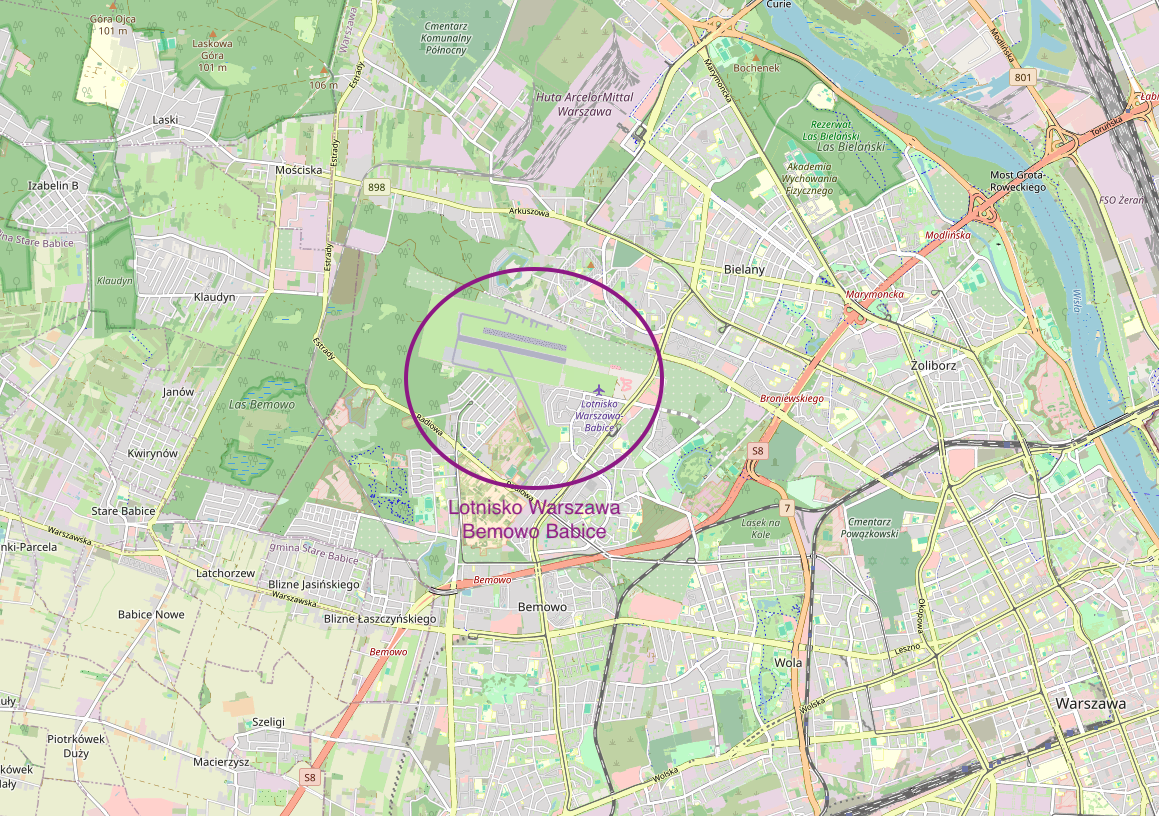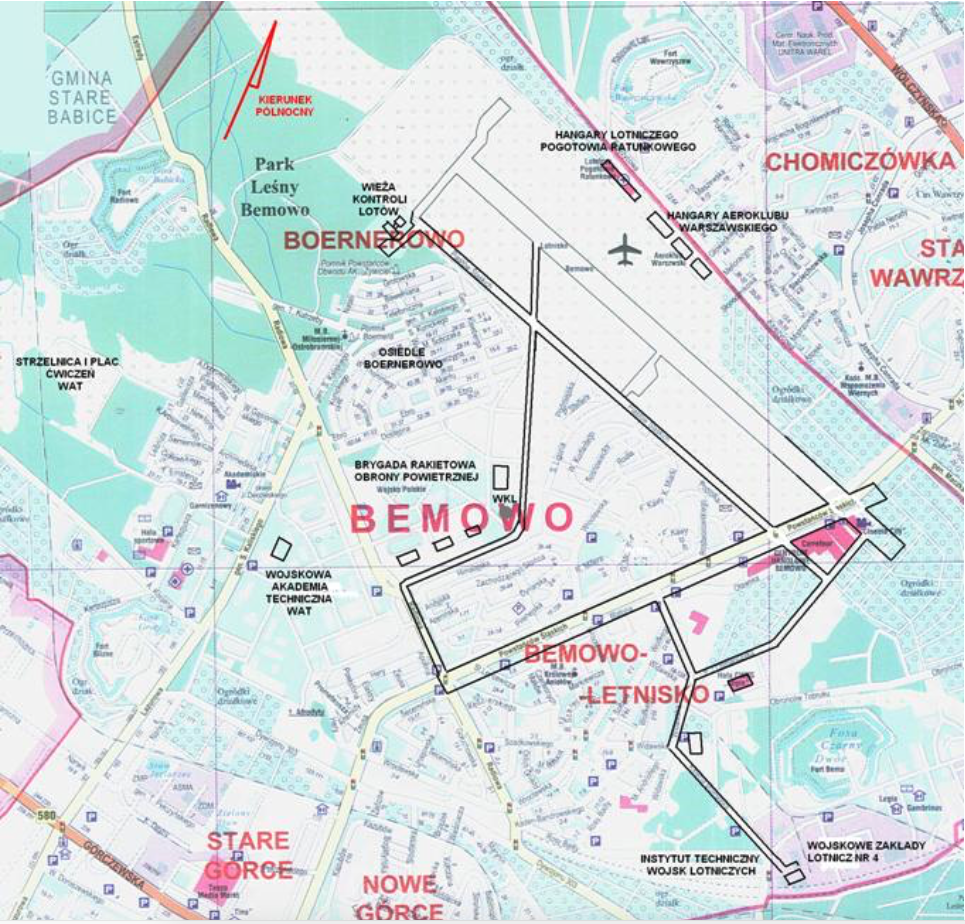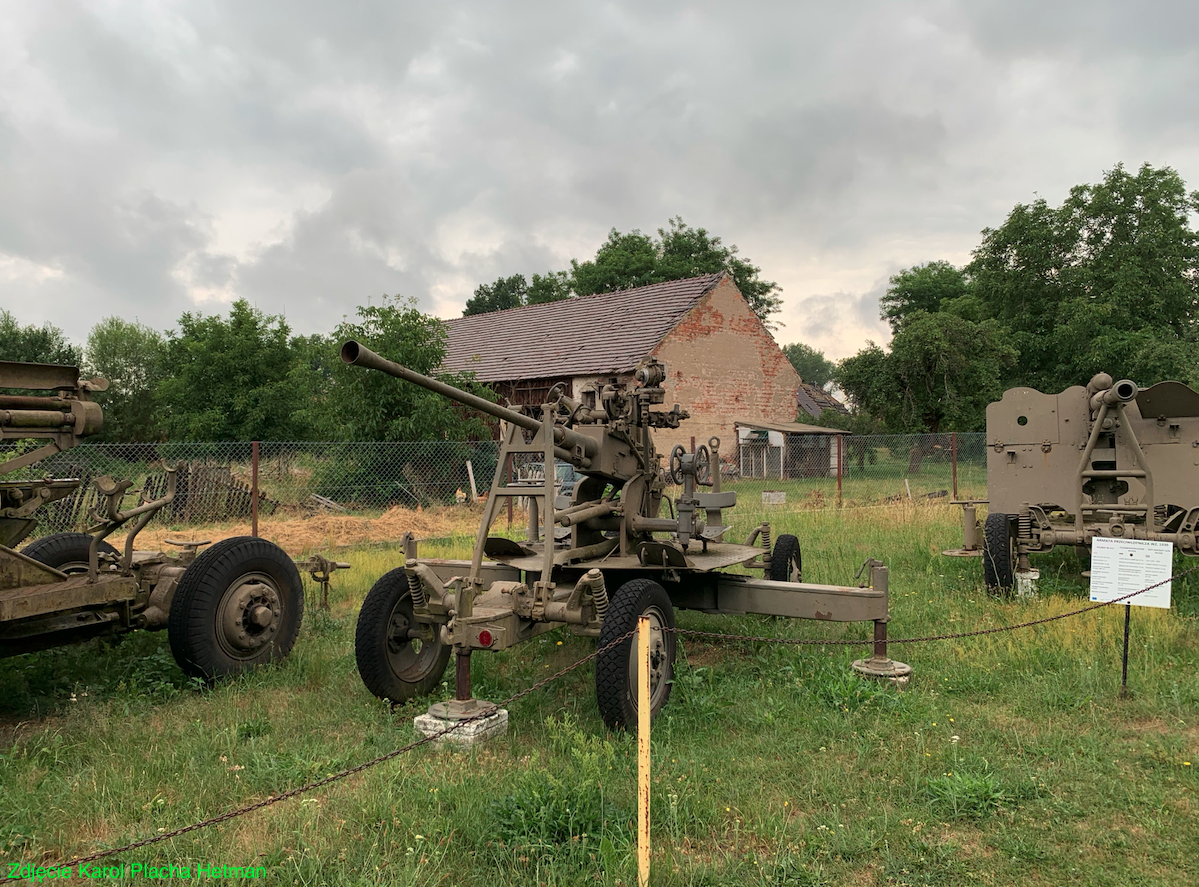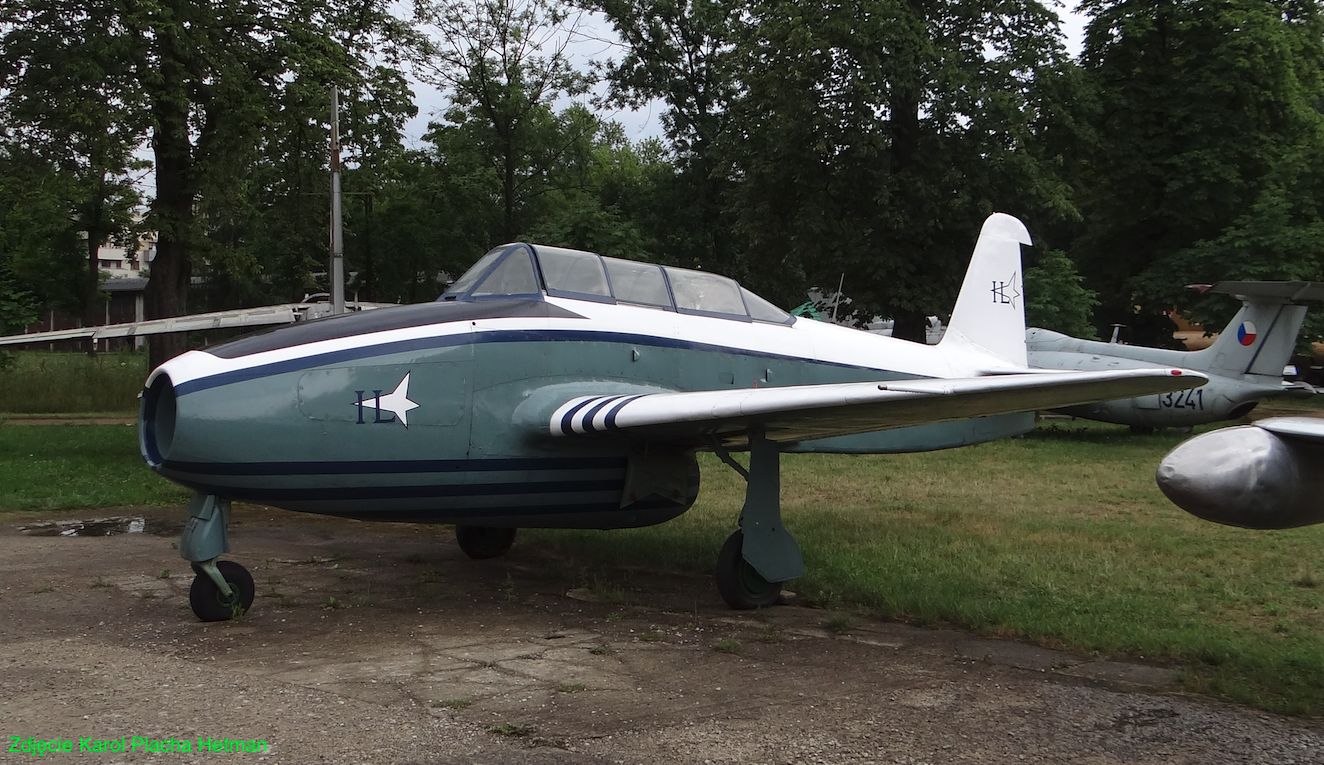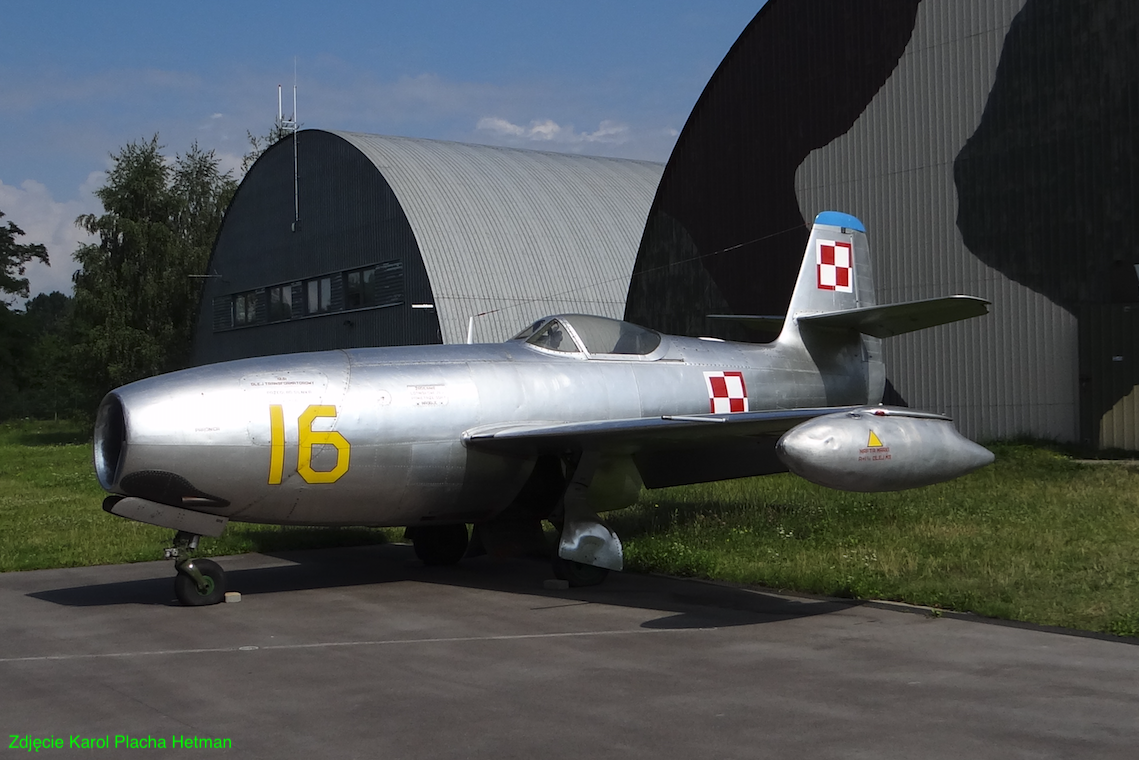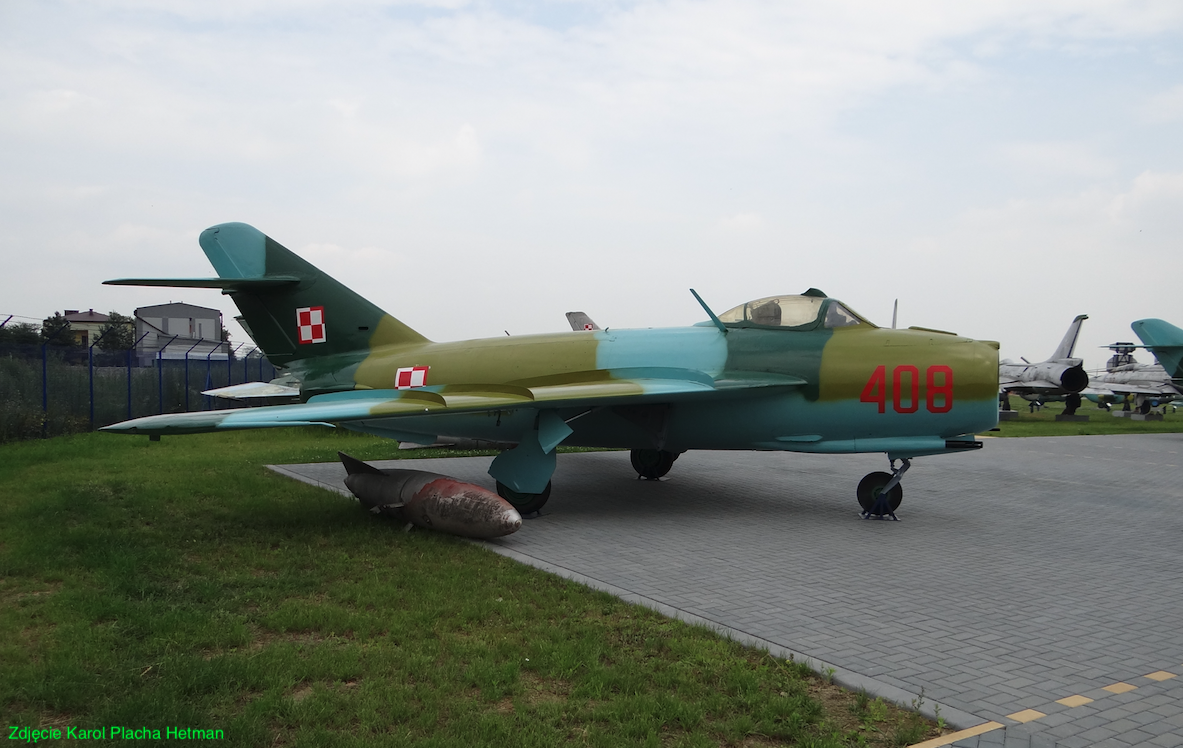Warszawa 2011-12-21
Lotnisko Bemowo-Babice-Boernerowo, Warszawa.
Współrzędne geograficzne: 52.268N 20.913E. Elewacja 104 m.
Wstęp.
W tytule, są trzy nazwy tego samego Lotniska, które na początku swego istnienia znajdowało się na przedmieściach Warszawy, a obecnie lotnisko jest w jej granicach. Interesujący nas teren to północno-zachodnie przedmieścia Warszawy. Teren ten przez kilka wieków pełnił ważne funkcje wojskowe. Tu przebiegał wewnętrzny i zewnętrzny pierścień umocnień, złożonych z budowli fortyfikacyjnych. Obecnie jest to dzielnica Warszawy, o nazwie Bemowo.
W pobliżu lotniska są trzy forty; Bema (Parysów), Fort Babice, Fort Wawrzyszew. Wszystkie one powstały pod koniec XIX wieku, a już w 1909 roku, straciły swoje funkcje. Fort Bema stał się w okresie 1924-1939, wytwórnią amunicji Nr 1 dla Polskiego Wojska. Podczas okupacji wojsko germańskie urządziło tutaj magazyny wojskowe. Po 1945 roku, wróciło tu Wojsko Polskie. Ford pod koniec 80-lat XX wieku, został przekazany Wojskowemu Klubowi Sportowemu Legia Warszawa. Fort II A Babice (Radiowo) – jego zabudowania wykorzystywano przez Nadawczą Radiostację Transatlantycką, w okresie 1922-1945. Fort Wawrzyszew; z chwilą likwidacji funkcji obronnych w 1909 roku, zaczął pełnić funkcje magazynowe. Obszar między tymi fortami pełnił głównie funkcje poligonowe i jako plac ćwiczeń. Szkolili się tutaj artylerzyści, używając ostrej amunicji. Część południowa, na przeważającym obszarze jest piaszczysta. Natomiast część północna jest terenem podmokłym. W czasie wielkiej wojny światowej, miejsce obecnego lotniska użytkowane było, jako lądowisko dla samolotów pruskich i ruskich.
W Rzeczypospolitej Polskiej. 1918-1939 rok.
Po odzyskaniu przez Rzeczypospolitą Polskę niepodległości obszar ten przejęło odrodzone Wojsko Polskie. W Forcie Bema urządzono fabrykę amunicji. Spory obszar nadal pełnił funkcję poligonowe. Szkolili się tutaj artylerzyści i saperzy. W 30-latach, na terenach Boernerowo wybudowano koszary, w których do września 1939 roku, kwaterowały pododdziały 1. Zmotoryzowanego Pułku Artylerii Przeciwlotniczej. W czasie okupacji wojsko germańskie umieściło tu między innymi warsztaty samochodowe. To są te tereny, które obecnie zajmuje Wojskowa Akademia Techniczna.
Wojskowa Placówka Badawcza. 1918 rok.
Sekcja Żeglugi Napowietrznej została stworzona w dniu 28 listopada 1918 roku, przy Ministerstwie Spraw Wojskowych. W ramach Sekcji, w dniu 20 grudnia 1918 roku, utworzono zaczątek placówki badawczo-technicznej pod nazwą Dział Naukowo-Techniczny, przemianowany wkrótce na Wydział. Pierwszą siedzibą Wydziału był Zamek Królewski w Warszawie. Z uwagi na to, iż ówczesne Bemowo było terenami wojskowymi, dlatego to tutaj prowadzono znaczną część prób lotniczych, samolotów eksploatowanych w Polsce. Głównie w zakresie strzelań powietrznych, których nie można było prowadzić na Mokotowie.
Rozszerzanie zadań technicznych spowodowało, że na mocy rozkazu organizacyjnego Oddziału I Sztabu Generalnego z dnia 11 listopada 1921 roku, Wydział Naukowo-Techniczny został przekształcony w Wojskową Centralę Badań Lotniczych (WCBL). Do głównych zadań WCBL należało badanie sprzętu lotniczego, odbiór samolotów z wytwórni oraz nadzór techniczny nad produkcją. Dokonujący się w lotnictwie postęp techniczny sprawił, że dotychczasowe struktury organizacyjne WCBL okazały się niewystarczające, stąd z dniem 1 sierpnia 1926 roku, WCBL została przekształcona w Instytut Badań Technicznych Lotnictwa (IBTL). Zakres wykonywanych zadań rozszerzono, kładąc szczególny nacisk na rozbudowę urządzeń stacji płatowców i silnikowej. Drugim bardzo ważnym zadaniem IBTL był udział w opracowywaniu programu rozwoju techniki lotniczej i przemysłu lotniczego w Polsce. 10 lat od czasu powołania IBTL, w dniu 1 sierpnia 1936 roku, zarządzeniem Departamentu Dowodzenia Ogólnego MSWojsk. IBTL został przemianowany w Instytut Techniczny Lotnictwa (ITL). Nowa nazwa Instytutu, to również nowa struktura organizacyjna. Jednym z najważniejszych zadań ITL było badanie pierwowzorów sprzętu lotniczego. Wymagało to opracowywania przepisów budowy samolotów, tworzenia warunków technicznych na samoloty i silniki przy współpracy z przemysłem lotniczym, opiniowania projektów i obliczeń, kontroli prób statycznych, wreszcie prób prototypów, w tym prób zdatności i użytkowych wraz z próbami wyposażenia i uzbrojenia zamontowanego na samolotach. Najbardziej wymierne wyniki pracy Instytutu to próby w locie.
Historia Lotniska Bemowo.
Sama lokalizacja lotniska, zaledwie 10 km od centrum Stolicy, może wydawać się niewłaściwa. Pamiętajmy jednak, że w drugiej połowie 40-lat, pierwsze samoloty myśliwskie z napędem turboodrzutowym miały bardzo mały zasięg. Dlatego logicznym było umieszczenie jednostek obrony w pobliżu bronionych obiektów. W Polsce podobnie postąpiono w Krakowie (Lotnisko Czyżyny-Rakowice) i Poznaniu (Lotnisko Ławica).
Ale nie tylko Polskie Wojsko na Bemowie miało swoje miejsce stacjonowania. Tutaj było całe centrum oddziałów sowieckich wspierających utrwalanie władzy komunistycznej w PRL.
Do tego celu niezbędne było własne lotnisko. Funkcjonowało ono, jako prowizoryczne lądowisko już od 1945 roku. Trudno jest wskazać datę powstania Lotnisko Bemowo. Lotnisko zapewniało lotniczą łączność z Moskwą, niezależną od Lotniska Okęcie. Sowieci nie mieli w zwyczaju powiadamiać Polskiego Wojska, którego jednostki kontrolowały Polską przestrzeń powietrzną, o zamiarze wykonania jakiegoś przelotu. Już w 1947 roku, wybudowano pierwszą utwardzoną drogę startową. Lotnisko powstało na tak zwanych Szwedzkich Górkach, między fortem Bema, a Boernerowem, wówczas poza granicami administracyjnymi Miasta Warszawy. Administracyjnie był to teren Gminy Blizne, którego urząd mieścił się w Starych Babicach. Dlatego Lotnisko nosi także nazwę Lotnisko Babice. Od 1945 roku, znaczny obszar dzisiejszego Bemowa został utajniony. Postronne osoby były legitymowane. Brak munduru lub towarzystwa osoby umundurowanej zwiastował kłopoty. To był obszar zamknięty dla ludności cywilnej. Drogi na Bemowo były oznaczone znakami, „Droga bez przejazdu”, a kończyły się bramami i szlabanami, które można było przekroczyć tylko posiadając przepustkę. Żołnierze sowieccy czuli się tutaj jak w Legnicy, czyli jak u siebie. Mieli własne stołówki, kantyny i sklepy.
Wokół Lotniska postawiono kilka baterii artyleryjskich (obrona przeciwlotnicza). Do obiektów doprowadzono nową bocznice kolejową.
Lotnisko posiadało dwie betonowe drogi startowe 5/23 o wymiarach 2 000 m x 80 m oraz 10/28 o wymiarach 2 500 m x 90 m. Drogi startowe krzyżowały się. Postawiono kilka hangarów. Zbudowano dużą bazę paliwową. Budowa Lotniska Bemowo trwała kilka lat i była prowadzona z wielkim rozmachem, według planów sowieckich. Przy budowie brali udział jeńcy germańscy, doprowadzani na teren budowy z pobliskiego obozu w Grotach. Lotnisko oficjalnie przekazano do eksploatacji w styczniu 1951 roku. Jednak infrastruktura Lotniska była niedokończona. Na lotnisku przeważały transportowe samoloty sowieckie. Przewoziły one regularnie żołnierzy, sprzęt i inne towary, w tym; gazety komunistyczne i pocztę specjalną.
Lotnisko przeznaczono, jako główną bazę dla 5. Dywizji Lotnictwa Myśliwskiego Wojska Polskiego, będącej początkiem tworzonego systemu Obrony Przeciwlotniczej dla Warszawy. Na Lotnisko przeniesiono dowództwo i sztab 5. DLM oraz 1. Myśliwski Pułk Lotniczy z Modlina. Dowódcą 5. DLM był w tym czasie sowiecki generał Grigorij Piatakow, a dowódcą 1. MPL także sowiecki podpułkownik pilot Aleksander Bystrow. W eksploatacji był w tym czasie stosunkowo nowe tłokowe Jak-9 P i kilka egzemplarzy starszych szkolnych Jak-9 W, które pamiętały drugą wojnę światową.
W 1951 roku, sowieci na Lotnisku umieścili szkołę przeszkalającą pilotów z maszyn tłokowych na myśliwce z napędem turboodrzutowym. (Do tej pory pilotów latających na samolotach z silnikami turboodrzutowymi szkolono w Brzegu Opolskim, w jednostce sowieckiej i byli to zwykle obywatele CCCP).
W kwietniu 1951 roku, dostarczono do Polski, na Lotnisko Bemowo, pierwsze 3 szkolno-treningowe maszyny Jak-17 W. Samoloty te, podobnie jak Jak-17 przybyły do Polski (Lotnisko Radom) w skrzyniach drogą kolejową. Nie były to jednak maszyny nowe. Samoloty zmontowano w hangarze Nr. 3. Maszyny te wyprodukowano w 1948 roku i eksploatowano w jednostce sowieckiej. Ich numery (seryjne / burtowe); 3120008 / 4, 3120127 / 7, 3120145 / … Znalazły się na wyposażeniu 1. MPL.
Nieco wcześniej, bo już w grudniu 1950 roku, granice CCCP-Polska przekroczył transport kolejowy z pierwszymi samolotami Jak-23, przeznaczonymi dla Lotnictwa Polskiego. Było to później niż w innych krajach demoludów, co świadczyło o braku zaufania do „bratniego narodu”. Jak-23 jest tym samolotem, który otworzył w lotnictwie Polskim erę samolotów odrzutowych. Pozbawiony wad poprzednika (Jak-17) był konstrukcją zdecydowanie dojrzalszą. Lecz w tych latach postęp w dziedzinie zespołów napędowych i aerodynamice był tak wielki, że o karierze tej konstrukcji nie można mówić. W światowym lotnictwie był to zaledwie epizod. Jednak nie dla naszych sił powietrznych.
Zgodnie z planem, w dniu 6 stycznia 1951 roku, na bocznicę kolejową Lotniska Bemowo podstawiono pierwszy transport. Na platformach znajdowało się kilkadziesiąt skrzyń. Ładunek umieszczono w hangarze Nr. 3. Obiekt ten był dodatkowo ogrodzony i obstawiony wartą. Jedna skrzynia mieściła jeden kompletny samolot, w stanie rozłożonym. Montażu samolotów dokonywali sowieccy i Polscy mechanicy i piloci. Sowieci wykonywali obloty i szkolili Polskich pilotów. W lutym 1951 roku, kolejne egzemplarze Jak-23 montowano, oblatywano i przygotowywano do przekazania do 1. MPL (myśliwski pułk lotniczy).
W ślad za nowymi samolotami na Lotnisko Bemowo do 1. Myśliwskiego Pułku Lotniczego przybyło czterech pilotów przeszkolonych w CCCP. Byli to piloci-instruktorzy; mjr Sapiecha, por Łochow, por Mareszkin, por Wołkowski. Zadaniem przybyłych instruktorów było wyszkolenie pierwszych Polskich pilotów, którzy już wstępnie przeszli przeszkolenie na odrzutowcach (samolotach turboodrzutowych), a ci z kolei mieli stworzyć kadrę przyszłych instruktorów.
Ponieważ zdawano sobie sprawę, że pilotów będzie za mało, dlatego już w lutym 1951 roku, wytypowano drugą grupę pilotów i techników do przeszkolenia na szkolno-treningowych Jak-17 W w sowieckim 156. PLM w Brzegu Opolskim na terenie kraju. Grupa liczyła 12 (15) pilotów i kilku techników. Byli wśród nich; ppłk (kpt) Wasyl Gaszyn, kpt Stanisław Więcek, kpt M. Bajczykow, kpt Tadeusz Krępski, kpt Eugeniusz Pniewski, kpt Stanisław Tanana, ppor Wiktor Iwoń, ppor Bolesław Smolik, ppor Andrzej Dobrzaniecki, ppor. (kpt) Stefan Płoszański, ppor Władysław Hermaszewski (brat Polskiego kosmonauty), kpt Mieczysław Goworek.
Piloci byli początkowo szkoleni na Jak-17 W (UTI) i wykonywali około 15 lotów, w łącznym czasie około trzech godzin. Potem przechodzili na samoloty Jak-23 i osiągali na nich nalot około 7 godzin. W kwietniu 1951 roku, powrócili oni na Lotnisko Bemowo, z uprawnieniami instruktorów.
Dzień 20 marca 1951 roku, był dla 1. PLM bardzo waży, gdyż w odczytanym tego dnia rozkazie pułk przeszedł od szkolenie na samolotach tłokowych do szkolenia na samolotach odrzutowych (turboodrzutowych). W tym okresie, pułk dysponował 16 Jak-23, 3 Jak-11, 6 Jak-9 P, 1 Jak-9 W, 3 Po-2, a już w kwietniu 1951 roku, stan wyglądał następująco; 30 nowych Jak-23 oraz 3 używane Jak-17 W.
W dniu 22 czerwca 1951 roku, doszło do pierwszego wypadku lotniczego samolotu Jak-23 nr 813 / 13. Podczas lotu treningowego w samolocie pilotowanym przez chorążego pilota Feliksa Nadowskiego zgasł silnik. Lotnik podjął decyzję o lądowaniu awaryjnym ze schowanym podwoziem w przygodnym terenie. Po lądowaniu pilota z kabiny wyciągnęli ludzie pracujący w polu. Pilot doznał uszkodzenia kręgosłupa, a samolot naprawiono.
Na początku kwietnia 1951 roku, rozpoczęto formowanie w Krakowie 7. DLM (dywizji lotnictwa myśliwskiego), rozkazem MON nr 0036/org. Dowódcą został Polski oficer, były szef UB w Warszawie i Krakowie podpułkownik pilot Jan Frey-Bielecki. Podstawową jednostką stał się 2. MPL stacjonujący w Czyżynach (Kraków). Pułk ten stał się zalążkiem kolejnych jednostek odrzutowego lotnictwa myśliwskiego.
Tymczasem cały 2. MPL w celu przeszkolenia przebazowano na Lotnisko Bemowo. Pierwsze zajęcia z nowym sprzętem przeprowadzono w dniu 2 maja 1951 roku. Szkolenie prowadzono w hangarze Nr 3, do którego dostęp był tylko za okazaniem specjalnej przepustki. Oba pułki (1. MPL, 2. MPL) szkoliły się razem. Cała kadra brała także udział w montażu kolejnych nowych egzemplarzy samolotów Jak-23.
Piloci 2. MPL od jednostki 1. MPL otrzymali na stan jeden samolot Jak-17 W nr 3120145. Pierwsze loty wykonali w dniu 9 maja 1951 roku, pod kierunkiem sowieckiego oficera majora Markowa.
W połowie maja 1951 roku, moskale przekazali do Warszawy czwarty egzemplarz samolotu Jak-17 W nr 3120124, a loty na nim rozpoczęli piloci 2. MPL. Podczas Święta Lotnictwa w 1951 roku, samoloty Jak-17 W wzięły udział w pokazach, przelatując w szyku obok myśliwców Jak-23.
Na początku sierpnia 1951 roku, zgodnie z planem, a dokładnie na mocy rozkazu DWL nr 064/org, przystąpiono do formowania trzeciej jednostki myśliwców odrzutowych, 13. PLM (MPL), jednocześnie zmieniając nazewnictwo na Pułki Lotnictwa Myśliwskiego. Dowódcą 13. PLM został major pilot Stanisław Więcek, a dowódcami eskadr; kpt pilot Kazimierz Tanana, por pilot Wiktor Iwonia, por pilot Bolesław Smolik. 13. PLM stacjonował początkowo w Warszawie (Lotnisko Bemowo), a następnie został przeniesiony do Łęczycy.
W dniu 18 sierpnia 1951 roku, 13. pułk otrzymał jeden samolot Jak-17 W nr 31200008 z warszawskiego pułku, a parę tygodni później drugiego Jak-17 W nr 3120127, gdyż 1. PLM przeszedł całkowicie na samoloty MiG-15 i UTI MiG-15.
We wrześniu 1951 roku, 1. PLM, jako pierwsza jednostka bojowa, wyposażona w samoloty myśliwskie Jak-23, uzyskała gotowość bojową. Dzięki temu Jak-23 stał się pierwszym użytkowym samolotem turboodrzutowym w Polsce.
Jeszcze nie zrealizowano całego kontraktu, na dostawę myśliwców Jak-23, a już w lipcu 1951 roku, rozpoczęto dostawy myśliwców MiG-15. Powodem był rozwój wydarzeń podczas wojny w Korei. Groźba wybuchu III wojny światowej była bardzo realna. Samolot MiG-15 sprawdził się w działaniach wojennych i przewyższał technicznie samolot Jak-23.
Lecz wydarzenia biegły bardzo szybko. W czasie, kiedy 1. PLM na Bemowie przygotowywał się do pierwszej defilady z okazji 22 lipca, podczas której miano zademonstrować po raz pierwszy myśliwce Jak-23, w dniu 19 lipca 1951 roku, wylądowały najnowsze myśliwce MiG-15. Było to 5 maszyn, które przyprowadzili piloci sowieccy bazujący na jednym z lotnisk obok Berlina, na terenie NRD. Przyprowadzone samoloty miały numery; 0227, 0231, 0234, 0236, 0249 i były wyprodukowane w 1949 roku.
Wkrótce na Lotnisku Bemowo pojawiły się pierwsze 4 egzemplarze szkolno-treningowych MiG-15 UTI. Przybyły one do Polski prawdopodobnie w dniu 30 lipca 1951 roku, a ich numery to; 104-11, 104-23, 104-24, 104-24.
Zgodnie z decyzją dowództwa 5. DLM w skład, której wchodził 1. PLM miał przejąć na uzbrojenie wszystkie dostarczane do Polski myśliwce MiG-15. W dniu 1 listopada 1951 roku, na stanie 1. PLM było już 30 samolotów MiG-15.
Samoloty MiG-15 zaczął także otrzymywać 13. PLM, który chwilowo posiadał myśliwce Jak-23. W grudniu 1951 roku, 5. DLM dysponująca 1. PLM i. 13 PLM, wyposażona była już w 60 samolotów MiG-15 i 4 samoloty MiG-15 UTI, które rozdzielono proporcjonalne pomiędzy oba pułki.
W 1952 roku, na Lotnisku Bemowo stacjonował już tylko 1. PLM. Przybywali tutaj kolejni nowi piloci na przeszkolenie na samoloty MiG-15.
W Mielcu, w połowie 1952 roku, uruchomiono produkcję seryjną licencyjnych samolotów MiG-15, pod nazwą Lim-1 (Licencyjny Myśliwiec). Pierwsza partia liczyła 6 egzemplarzy i była wykonana z części dostarczonych z CCCP. Zbudowano ją w ramach szkolenia załogi. Samoloty otrzymały numery fabryczne od 1A 01-001 do 1A 01-006. We wrześniu 1952 roku, samoloty te przekazano wojsku dostarczając je na Lotnisko Bemowo. Tutaj wykonano na nich serię testów lotniczych, aby wychwycić ewentualne błędy, a także wprowadzić pewne modyfikacje. Kolejne Lim-1 trafiały już do pozostałych jednostek lotniczych.
Na zakończenie 1952 roku, 1. PLM osiągnął pełny stan maszyn w licznie 36 egzemplarzy MiG-15 / Lim-1 oraz 2 UTI MiG-15.
W drugiej połowie 1955 roku, do Polski dostarczono pierwszą partię 12 myśliwców MiG-17 PF. Samoloty te posiadały pokładowe celowniki radiolokacyjne, które zapewniały przechwycenie celów w każdych warunkach atmosferycznych. Do CCCP udała się grupa wybranych pilotów celem przeszkolenia się na nowe samoloty MiG-17 PF. W gronie tym byli między innymi piloci; kpt. Czajka, por. R Operacz, por. S Radziejowski, por S Nyc. Szkolenie odbywało się w Lipiecki i Taganrogu. Po powrocie do kraju na Lotnisku Bemowo utworzono z tych pilotów i z samolotami MiG-17 PF, 21. Samodzielną Eskadrę Myśliwską w ramach Układu Warszawskiego. Jednostka przechwytująca działała przy 1. PLM Warszawa. Na dowódcę wyznaczono kpt. Czajkę. 21. Samodzielna Eskadra Myśliwska w 1957 roku, została wcielona w struktury 1. PLM.
W lipcu 1957 roku, 1. PLM przebazowano na lotnisko w Janowie koło Mińska Mazowieckiego. W ten sposób na Lotnisku Bemowo zakończyła się era bojowych pułków lotniczych.
Inne jednostki lotnicze na Lotnisku Bemowo.
Eskadry Lotnictwa Transportowo-Łącznikowego MSW.
103 Pułk Lotniczy MSW.
103 Pułk Lotniczy (JW 1159) – Warszawa-Bemowo i Bielany (Wrzeciono, ul. Marymoncka).Lotnisko Bemowo, jak żadne inne w kraju, było i jest silnie związane z szeroko rozumianym wewnętrznym porządkiem publicznym. Lotnicze jednostki podległe administracji publicznej tutaj stacjonowały i stacjonują. Od samego początku bazowała tu jednostka lotnicza podległa pod Korpus Bezpieczeństwa Wewnętrznego. Jednostka ta dysponowała samolotami transportowymi Li-2, Po-2. W 1950 roku, przyjęła na stan pierwsze samoloty Ił-12.
Zaczęło się od lotniczej jednostki łączności podległej Korpusowi Bezpieczeństwa Wewnętrznego (KBW), który z kolei podlegał ministrowi bezpieczeństwa publicznego (1945 – 1954), a następnie ministrowi spraw wewnętrznych. Głównym ich zadaniem była likwidacja Polskiego podziemia niepodległościowego. KBW stało się wojskami wewnętrznymi. Bazą do formowania KBW był Samodzielny Batalion Szturmowy, sformowany w dniu 18 października 1943 roku, który w dniu 21 marca 1944 roku, został przekształcony w Polski Samodzielny Batalion Specjalny, który z kolei został przekształcony w Brygadę Wojsk Wewnętrznych. Brygadę stale rozbudowywano i bardzo zróżnicowano. Z każdym rokiem zadań przybywało, a wszystkie były podporządkowane zapewnieniu porządku wewnętrznego, niezbędnego do wprowadzenia w życie decyzji aparatu władzy ludowej. Pierwszym doświadczeniem (również lotniczym) było sfałszowane referendum ludowe z 1946 roku, a następnie sfałszowane wybory do Sejmu z 1947 roku. W tym okresie, na porządku dziennym były dezercje całych zorganizowanych pododdziałów z szeregów nowo powstałych Wojsk Wewnętrznych, w związku z zadaniami milicyjno-porządkowymi, jakie przydzielano żołnierzom. Sednem sprawy była podległość nie dowództwu wojskowemu, ale bezpośrednio aparatowi władzy PZPR.
Jednym z zadań KBW była ochrona, zaopatrywanie i konwojowanie, realizowane w ważniejszych obiektów przemysłowych, obozach jenieckich, obozach dla internowanych przeciwników politycznych, obozach odosobnienia i pracy. Ochraniano przymusowe ściąganie kontyngentów żywnościowych na wsi. Inne zadania to; kontrola ruchu ludności, tworzenie posterunków kontrolnych na rogatkach miast i dworcach kolejowych, rozminowywanie, zwalczanie skutków klęsk żywiołowych (pożarów i powodzi). Inne zadania wynikające z doraźnej potrzeby zachowania steru władzy, np. pacyfikacja strajkujących i protestujących pracowników. Oddziały KBW aktywność wykazały podczas Poznańskiego czerwca 1956 roku. Struktury KBW, UB, MO, ZOMO i ORMO były bardzo mocno połączone i wzajemnie się przenikały.
Z początkiem 60-lat KBW posiadało ponad 60 jednostek organizacyjnych typu wojskowego (inżynieryjne, saperskie, samochodowe, pancerne, lotnicze, mostowo-pontonowe, ochrony, łączności, przeciwpożarowe). Posiadało własne ośrodki szkoleniowe i poligony.
W połowie 60-lat powołano do istnienia Nadwiślańskie Jednostki Wojskowe, które przejęły jednostki KBW. Ale myliłby się czytelnik, że KBW zniknęło. Układ był taki, jak ilustruje poniższy przykład; Jednostka stała się typową wojskową jednostką samochodową, podległą dowództwu wojsk lądowych. Żołnierze na czapkach nosili otoki zielone. Ale kiedy wprowadzono stan wojenny (13 grudzień 1981 rok) , jednostka stawała się oddziałem KBW, a żołnierzom kazano nakładać otoki granatowe (wyróżnik wojsk wewnętrznych) i wysłano w patrolach samochodowo-pieszych do miast, często z ostrą amunicją. W 80-latach XX wieku, główny ciężar utrzymania władzy spoczął na oddziałach ZOMO i Milicji, które w swoich szeregach posiadały lojalnych komunistów. Konia z rzędem temu, kto rozumie meandry w Ministerstwie Spraw Wewnętrznych Rzeczypospolitej po 1989 roku; Służba Bezpieczeństwa MSW, Urząd Ochrony Państwa, Agencja Bezpieczeństwa Wewnętrznego, Wojskowe Służby Informacyjne, Biuro Ochrony Rządu, agenturalna siatka moskiewska, powiązania partyjno-biznesowo-gangsterskie i Bóg jeden wie co jeszcze. Jest to efekt braku lustracji i dekomunizacji. Prezydent Rzeczypospolitej Lech Wałęsa, wyprowadził wojsko sowieckie z Polski, ale nie zlikwidował sowieckiej siatki szpiegowskiej.
Napisaliśmy o tym, aby uświadomić czytelnikowi, jak ważne było Lotnisko Bemowo, dla realizacji tych wszystkich zadań. Zadań stałych i doraźnych. Wymagających użycia samolotów i śmigłowców. Obecnie, trudno jest ustalić, które samoloty i śmigłowce na stałe bazowały na Lotnisku Bemowo w ramach Eskadry Lotnictwa Transportowo-Łącznikowego MSW, a później 103. Pułku Lotniczego. Jednym z problemów była wymiana sprzętu z 36. SPLT z Okęcia, a także z innych jednostek lotniczych rozrzuconych po kraju.
Na pewno, na Lotnisku Bemowo bazowały pierwsze sprowadzone do Polski śmigłowce Mi-1, a następnie Mi-4. Znany jest fakt wykorzystania śmigłowców w zadaniu milicyjnym z 1965 roku, kiedy to po raz pierwszy zostały poderwane w powietrze dwa śmigłowce Mi-4 i dwa śmigłowce SM-1 Eskadry Lotnictwa Transportowo-Łącznikowego MSW, w celu poszukiwania zbiegłych z więzienia w Krośnie przestępców. Niezależnie od prowadzonych poszukiwań, wzdłuż prawdopodobnej trasy ucieczki skazanych, rozrzucano ulotki z komunikatem milicyjnym.
Około 1965 roku, Eskadra Lotnictwa Transportowo-Łącznikowego MSW została przekształcona w 103. Pułk Lotnictwa Nadwiślańskich Jednostek Wojskowych MSW. Pułk doposażono między innymi w śmigłowce Mi-2. Przybywało zadań wykonywanych na rzecz resortu spraw wewnętrznych. Nie rozróżniano wówczas zadań na milicyjne i wewnętrzne.
Wielu pamięta, jak w 70-latach XX wieku słynny wyścig kolarski „Wyścig Pokoju” był relacjonowany na żywo z pokładu śmigłowca Mi-2. Jednak nieliczni wiedzą, że powstanie takiej odmiany wojskowej śmigłowca narodziło się z myślą o rozpoznaniu powietrznym przeciwnika. Początkowo przy pomocy kamery filmowej, a następnie z transmisją on-line, do punktu dowodzenia. Komunistyczna władza szybko dostrzegła, możliwość wykorzystania tej techniki dla pacyfikowania strajków, buntów, pochodów i tym podobnych „wrogich” akcji. Relacje z „Wyścigu Pokoju” były tylko epizodem, ku uciesze gawiedzi.
Od 1977 roku, 103. Pułk Lotniczy MSW przejął na stan śmigłowce Mi-8. Było ich 21 egzemplarzy, niemal wszystkie w wersji Mi-8 T. W 1989 roku, 103. Pułk Lotniczy MSW przejął na stan cztery śmigłowce Mi-17. Do 1995 roku, 103. Pułk Lotniczy MSW samodzielnie zabezpieczał całą działalność lotniczą w resorcie, wykonując w pełnym zakresie również zadania policyjne. Od 1995 roku, zaczęły powstawać lokalne ośrodki lotnicze Policji w Krakowie i Poznaniu. W 2000 roku, 103. Pułk Lotniczy MSW został rozformowany. Jego sprzęt rozdysponowano do jednostek wojsk lądowych i policji, która przejęła aż 11 maszyn. Lotnictwo policji uroczyście swoją działalność zainaugurowało w dniu 9 maja 2001 roku. Siedzibą Wydziału Lotniczego ZL KGP w Warszawie pozostało Lotnisko Bemowo. Tutaj na stałe bazują; 3 śmigłowce Mi-8, dwa śmigłowce W-3 Sokół i jeden Bell-206.
Dalsza historia lotniska Bemowo.
Kiedy wzbił się w powietrze pierwszy sowiecki samolot pasażerski z napędem turboodrzutowym Tu-104, zachwytom w całym bloku wschodnim nie było końca. Maszyna powstała na bazie wprowadzonego już na uzbrojenie bombowca typu Tu-16 i odznaczała się dobrymi charakterystykami w locie. Niestety na ziemi podczas lądowania i startu było znacznie gorzej. W marcu 1956 roku, trzy pierwsze maszyny Tu-104 zostały zademonstrowane po raz pierwszy za granicą, na lotnisku Heathrow w Londynie. Było to w czasie wizyty najwyższych władz CCCP w UK. Co ważne, sowiecka delegacja, z Chruszczowem na czele, do Londynu popłynęła na pokładzie okrętu wojennego. Po prostu, konstruktor Tupolew obawiał się ewentualnej katastrofy nie do końca przetestowanych samolotów. Kiedy samolot Tu-104 chciano pokazać w Polsce, w Warszawie to musiał przylecieć bez pasażerów (obciążenia) i lądować z użyciem dwóch spadochronów hamujących (Tak samo było w Londynie).
W dniu 24 lipca 1956 roku, na Lotnisku Bemowo wylądował właśnie samolot Tu-104 i był to pierwszy samolot pasażerski z napędem turboodrzutowym, który przyleciał do Polski. Oprócz załogi na pokładzie samolotu była niewielka grupa pracowników biura OKB Tupolew. Przez trzy dni samolot obejrzało 100 000 warszawiaków, czyli co dziesiąty mieszkaniec Warszawy. Odlot nastąpił w dniu 27 lipca 1956 roku, także bez większego obciążenia. Nasi specjaliści od razu zorientowali się, że nie jest to samolot dla naszego przewoźnika PLL LOT. Nie będziemy wydłużać dla niego RWY. Aby uratować sytuację, OKB Tupolewa opracowało Tu-124 ze skróconym kadłubem i lżejszy wagowo, który zabierał zaledwie 40 pasażerów. Ta maszyny bez trudu mieściła się na typowej RWY. Propagandowo Tu-124 był nadal oznaczany jako Tu-104 i to on głównie przewoził pasażerów. Ta modyfikacja zbiegła się z katastrofą Tu-104, która miała miejsce w 1959 roku. Samolot nagle, jakby uderzony od spodu, wszedł w ostre wznoszenie. Doszło do przeciągnięcia i samolot z wysokości 9 000 m runął na ziemię. Szczątki maszyny i cała ofiar były rozrzucone w promieniu 2 000 m. Przyczyna nie została wyjaśniona. Oczywiści oficjalnie, winna była załoga.
W 1959 roku, na Lotnisko Bemowo wylądował samolot Boeing B 707 z wiceprezydentem USA Richardem Nixonem. Na Lotnisku Bemowo we wrześniu 1967 roku, wylądował Charles de Gaulle, który przyleciał samolotem Caravelle.
Wojsko Polskie wycofywało się z okolic Lotniska Bemowo etapami, od początku 70-lat, a jego miejsce zajęły osiedla mieszkaniowe. Pozostał tylko pas idący w stronę „śmieciogóry”. Dopiero w 80-latach, wojsko przekazało część terenów dla Miasta, pod zabudowę mieszkaniową. Od tego okresu jest jawny konflikt interesów zarządców Lotniska, a władzami Miasta.
Ciąg dalszy w kolejnym rozdziale.
Opracował Karol Placha Hetman

